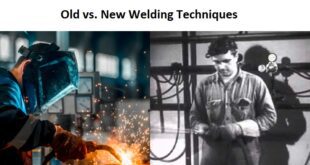Aluminum Welding Challenges and Solutions Introduction Aluminum welding stands at the forefront of modern fabrication techniques, playing a pivotal role across diverse industries. This introductory section delves into the essence of aluminum welding, elucidating its definition and underscoring its significance in various sectors. Definition of Aluminum Welding Aluminum welding refers …
Read More »Types of Welding Machines
Types of Welding Machines Welding is a fabrication process that involves joining two pieces of metal or thermoplastic materials by melting them and allowing them to cool and solidify together. Welding is a crucial process in many industries, including construction, manufacturing, and automotive. Welding machines are essential tools for welding, …
Read More »Old vs. New Welding Techniques
Old vs. New Welding Techniques: Bridging Tradition and Innovation Introduction Welding, a process that unites materials through heat and skill, stands as a cornerstone of industrial development. The evolution of welding techniques, from the age-old traditions to the cutting-edge innovations of today, paints a fascinating portrait of progress in the …
Read More »Welding in Automobile Sector
Welding in Automobile Sector: Enhancing Structural Integrity and Safety Introduction In the dynamic world of automotive manufacturing, welding plays a crucial role in ensuring the structural integrity, safety, and overall performance of vehicles. The welding process binds various components together, creating a cohesive unit that can withstand the demands of …
Read More »Mold Tool and Die Repair Welding
Mold Tool and Die Repair Welding Introduction Overview of mold tool and die repair welding Mold tool and die repair welding is a specialized process used to restore and repair damaged molds and dies used in various industries, such as manufacturing, automotive, and aerospace. Welding techniques are employed to fix …
Read More »Welding Temperatures Guideline
Welding Temperatures Guideline Introduction Controlling welding temperatures is of utmost importance in ensuring the quality and integrity of welds. The temperature at which welding takes place plays a significant role in determining the mechanical properties, metallurgical characteristics, and overall performance of the welded joint. Failure to control welding temperatures can …
Read More »Micro and Nano-scale Welding
Micro and Nano-scale Welding Introduction Definition and Significance Micro and nano-scale welding refers to the process of joining or bonding materials at extremely small dimensions, typically in the range of micrometers (μm) to nanometers (nm). It involves the fusion of materials at a microscopic or nanoscopic level to create strong …
Read More »Types of Welding Power Supplies
Types of Welding Power Supplies Introduction Welding power supplies are essential components in various welding processes. They play a crucial role in providing the necessary electrical energy and control parameters to create and sustain the welding arc. The proper selection and utilization of welding power supplies are vital for achieving …
Read More »Keyhole Welding
Keyhole Welding Introduction Definition and Explanation of Keyhole Welding Keyhole welding is an advanced welding technique that involves the creation of a keyhole or hole at the leading edge of the weld pool. It is achieved by using a concentrated heat source, such as a laser or an electron beam, …
Read More »Welding Techniques for Thin Metal
Welding Techniques for Thin Metal Introduction Welding thin metal presents a unique set of challenges and considerations for welders. The delicate nature of thin metal requires specific techniques to ensure successful and reliable welds without distortion or burn-through. In this comprehensive guide, we will explore various welding techniques tailored for …
Read More » Welding of Welders All about Welding and Welders
Welding of Welders All about Welding and Welders









